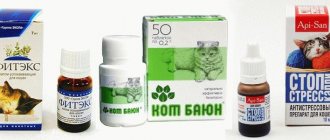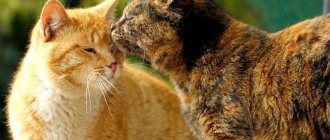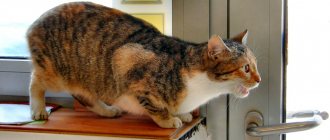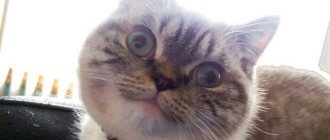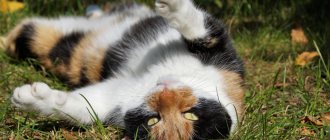A sedative for cats is used to reduce stress in animals when changing their usual lifestyle: before going to the veterinarian or during possible trips on transport.
The nervous system of cats is very sensitive, which explains their violent reaction to stressful conditions. Nervousness in furry pets manifests itself in the form of increased anxiety and aggressiveness. The solution to the problem in such situations can be special sedatives.
Calming medications for cats come in different types. Sedatives are available in the form of tablets, drops, sprays and collars.
Drugs should be given to animals only after consultation with a doctor, strictly following the rules of use and the permissible dose.
When can you use sedatives on your cat?
Cats are amazing creatures with sensitive nervous systems. For them, the cause of stress and the development of neurosis can be a change in their usual environment, especially at a young age, as well as puberty. Often cats begin to show aggression if a new pet appears in the house. The reason for stress in furry animals can be childbirth and the period after birth, associated with the fear of losing kittens. Sedatives have a cumulative effect, and to prevent the occurrence of an unpleasant condition, the drug should be given to the cat two weeks before the intended trip. Sedatives should be given to cats with caution. In some cases, the use of a natural sedative is sufficient; in other situations, the use of chemicals or tranquilizers is required, which must be prescribed by a veterinarian.
Symptoms of increased anxiety in a cat include frequent licking of fur and marking territory, aggression towards the owner, family members and oneself, hyperactivity, obsessive movements of the tail, head or paws. A cat's nervous state may be indicated by constant meowing, tearing out fur or sucking tissue, a fixed gaze, gluttony followed by vomiting, and hunting for non-existent prey.
The use of sedatives can reduce stress in your pet and make a difficult period for him more harmless and easily overcome.
Cats are given sedatives for:
- change of place of residence. Cats do not tolerate changes in their environment or home. This is stressful for them, and it takes them some time to adapt to their new place of residence;
- fears and increased anxiety . The cause of excessive nervousness is noisy guests, small children who run after the cat and want to play with it. A cat that can barely tolerate the affection of its owner, with fear and hostility, succumbs to the sometimes unkind stroking of strangers. She doesn’t understand what’s going on around her, what these strangers want, and she develops fears and anxiety. In this case, a sedative is an excellent way to prevent depression in a pet.
- nervous disorders . In some cases, cats experience a progressive nervous or mental disorder without clearly defined causes. In addition to the other characteristic symptoms mentioned above, the pet may experience involuntary head twitching and sudden jumps. Such disorders require examination at a veterinary clinic and the use of not only sedatives, but also medicinal drugs;
- participation in exhibitions, visits to a grooming salon and a veterinarian, vaccinations. Preliminary intake of sedative drops or tablets will allow you to organize the proposed activities more painlessly and without damage to the cat’s nervous system;
- intensive marking of the apartment territory by the cat. Certain sedatives help reduce the desire of cats to leave marks on all corners throughout the apartment, and also suppress the hormonal explosion.
When traveling by car or bus
Moving in any type of vehicle is extremely stressful for a cat. The reasons for depression in pets are a large number of unfamiliar people, unusual smells, noise, hum, and shocks in transport. Panic can also be caused by the owner’s nervous state associated with a long journey, because cats are able to detect mood changes and anxiety in their loved one.
During the flight
It is not recommended to sedate your cat before a flight without the advice of a veterinarian, as this will lead to a decrease in blood pressure, which is dangerous during the flight. When flying with a cat, you can use Feliway, which helps reduce anxiety in cats. Buprenorphine, Gabapentin and Alprazolam are also effective and are also used to reduce anxiety in cats during travel.
After sterilization
Sterilization causes changes in hormonal levels and causes anxiety and aggressiveness in the pet. This condition is also observed in cats during the period of sexual desire and estrus. Special sedatives help eliminate the symptoms of hypersexuality, depression and irritability as a result of changes in hormonal balance. In this case, experts recommend the use of natural-based drugs.
Video - How to calm a cat during heat at home: making a bandage
What not to do
Cats are very smart and can be offended by their owner for various reasons. The main thing is to remember that any reaction of the animal is natural, but not subject to your understanding. The pet acts as its instincts tell it to. Therefore, I will list what you should never do if your pet is overexcited.
- Trying to reason with him with words is useless.
- Raise your voice and use physical force. This will only aggravate the situation and cause mistrust.
- Approach a worried animal in open clothing. Even if your cat has never bitten you before, if she is in a bad mood she may attack in order to defend herself.
- Lose one's temper. The cat perfectly captures the emotions of the owner, and if she feels that she can control you, her authority will be lost, as well as the opportunity to influence her condition.
Friends, in this article I told you all the known and tested ways to calm a cat. If you know of others, please share them in the comments. Let's exchange experiences.
How the drugs work
Sedatives are divided into long-acting and fast-acting drugs. They are developed on a natural basis (homeopathic), and chemical preparations are also produced.
Sedatives are produced in the form of tablets, drops, sprays and collars.
Homeopathic remedies are long-acting drugs, while chemical remedies have an immediate effect. However, chemicals can have a negative effect on the body. Cats should be given sedatives with a chemical composition only after consulting a doctor.
After using sedatives, the pet becomes calm and less aggressive. It is recommended to use sedatives at the first signs of stress to avoid nervous exhaustion in your cat.
Medications used to prevent stress in cats include sleeping pills, which are often used when transporting pets. Sleeping pills are divided according to their duration of action: short, medium, long.
Mechanism of action
Experts divide sedatives for cats into 2 types: homeopathic and chemical. Regardless of the principle of action of the product, its effect is aimed at:
- pressure correction;
- beneficial effect on the nervous system;
- suppression of feelings of fear;
- Relieving tension.
Overview of anti-anxiety drugs
Cat owners should familiarize themselves with the variety of sedative medications available so that they can be used correctly when necessary. The drugs must be used carefully, taking into account contraindications and possible negative effects as a result of their use.
Natural sedatives for cats can be used at home. They have a prolonged effect and have a positive effect on the cat’s nervous system. They can be added to food in advance, an hour before moving.
Injections, tablets and drops with a chemical composition act faster and have a strong effect. To prevent side effects, you must follow the frequency of administration, dosage and veterinarian recommendations.
It must be borne in mind that conventional sedatives are ineffective against hormonal explosion in adult pets. To eliminate symptoms and suppress excessive sexual desire, veterinarians prescribe hormonal drugs.
Light sedatives for cats normalize the nervous system. In case of serious mental disorders, you need to consult a specialist. In most cases, the doctor prescribes chemical tranquilizers with an increased dose.
Not all pets tolerate sedatives well. Many people experience allergies or other side effects. If your cat develops excessive drowsiness, nausea, or lack of coordination of movements, you need to have the cat's stomach lavaged at a veterinary clinic.
A unique sedative collar has been created for pets with increased sensitivity to sedatives. The collar is suitable for pets of all ages, it resembles a regular anti-parasitic accessory, but emits a specific smell around itself.
The sedation collar is used only when necessary. It is effective when planning the arrival of a large number of guests, during a flight, or when a new pet appears in the house. An overdose when using a collar is excluded, so it is considered the safest product for cats.
Stop – stress
The drug is available in the form of drops in 10 ml bottles. The product contains a complex of extracts of medicinal plants, in particular extracts of catnip, motherwort, hops, Baikal skullcap, as well as phenibut (aminophenylbutyric acid). The drug reduces anxiety, calms, relieves stress.
A single dose of the drug is one drop per kg of cat’s weight. For corrective purposes and in case of increased excitability, giving the drug to an animal for more than one month is not allowed. Before moving or gumming, drops are used a few days before the event and another 1-4 days after it.
Fitex
The composition of the drug includes extracts of medicinal plants on a water-glycerin basis. The active ingredient used is a thick extract of valerian rhizomes.
Available in the form of 10 ml drops in polymer dropper bottles. Drops with a sedative effect normalize the activity of the central nervous system, stabilize the cardiovascular system and blood pressure. They have antispasmodic and anxiolytic (weakening the feeling of fear) effects.
Apply orally to the root of the tongue and into the cheek pouch (or with a small amount of treat) 1 hour before feeding the animal, 3 times a day in a dose of 3-5 drops, for 15-30 days.
Antistress
This is a mild sedative based on motherwort. Antistress contains vitamins B and C, dry yeast, carbohydrates, proteins, seaweed, taurine and calcium glycerophosphate. In addition to the calming effect, Antistress also has a general strengthening property, prevents the occurrence of stress and depression and helps the animal to tolerate them better. The dose is 2 tablets per 5 kg of pet’s weight. This drug can be used with food.
cat Baiyun
This drug is available in the form of aqueous tincture or tablets with extracts of medicinal plants. The product contains exclusively natural ingredients, and therefore the drug does not cause an allergic reaction.
Due to its natural composition, the drug has antispasmodic, analgesic and sedative properties, which, by easing anxiety and fear, calm the animal. The sedative normalizes the pet’s behavior and strengthens its body. The duration of the course depends on the cat’s behavior and can range from 5 to 7 days. Single dose - 2 tablets. The tincture should be given 3-4 times a day for 5-7 days, 2 ml (half a teaspoon). You can use a dispenser cap that has a graduated scale.
Interesting video: What happens if you give a cat “Cat Bayun”
Xylazine
The drug is a thiazine derivative and has a powerful sedative effect. Available in the form of a solution for injection. The medicine has an immediate effect, the effect after administration appears after 5-10 minutes. It is used as an anesthetic drug, has an analgesic and sedative effect.
The drug is also used during medical procedures and operations. Injections are given intramuscularly or subcutaneously, at the rate of 1-2 mg of 2% Xylazine per 1 kg of pet’s weight. The drug may only be injected under the supervision of a veterinarian.
Fospasim
The drug is a homeopathic anti-stress remedy. Available in the form of a solution for injection and drops for oral use. Helps correct the emotional and psychological state of animals. The use of the drug helps reduce aggressiveness and fearfulness in cats, and increases the body’s adaptive reactions. Drops are administered orally 1-2 times a day for 7-14 days, 3 drops per 1 kg of animal weight. To correct neuroses, behavioral disorders, increased excitability, and stressful conditions, Fospasim is administered once a day for 5-14 days, 0.1 ml per 1 kg of animal weight.
Vetspokoin
Vetspokoin is an effective antiemetic for animals based on phenibut, promethazine, motherwort extracts, valerian and natural royal jelly. The drug has a mild sedative, antiemetic, antispasmodic, stress-protective and adaptogenic effect. Vetspokoin helps normalize cat behavior (reduces aggressiveness, increased fearfulness), helps relieve symptoms of motion sickness in transport (vomiting, salivation, anxiety), reduces stress and improves interspecies relationships. The drug contains B vitamins, minerals, amino acids, and enzymes.
Feliway pheromone for cats
Calming medications for cats are also available in spray form. Feliway is one of these remedies. The medicine accurately recreates the pheromones of the facial glands that cats use to mark territory. The drug creates a feeling of safety and calm in the animal. Odors are detected by receptors in the olfactory epithelium of the nasal cavity, and the perception of pheromones in cats is carried out in the vomeronasal organ (VNO), also called the vomeronasal or Jacobson's organ.
Use the spray when carrying a cat, before transportation, when a pet moves to a new place of residence, as well as in the enclosure of a hotel intended for animals, when kittens are early weaned from their mother, to eliminate aggression associated with the touch of strangers, in case of uncleanliness, in group keeping cats.
It is not difficult to use the spray; the diffuser is plugged into an electrical outlet, the contents of the bottle evaporate and circulate in the air, normalizing the cat’s emotional state. The area of effect of one diffuser is 50-70 square meters. The validity period of one bottle is 30 days.
Advice from veterinarians before traveling
There are several simple recommendations for owners that will help reduce the level of anxiety of the animal. So:
- Cats, as mentioned above, are very perceptive and sensitive creatures. They literally read the mood of their owner. Therefore, before the trip, you need to remain calm: you should avoid fuss when packing your things. Excessive emotionality and excitability will instantly be transmitted to your furry friend. The best solution would be to gradually collect things and not rush.
- It is necessary to take care in advance about choosing a sedative for your cat on the road. It is advisable to give preference to one or another drug after visiting a veterinarian and receiving his recommendations. Reading owner reviews will be a big help.
- Special attention should be paid to the cat carrier - it must be made of high-quality materials and match the size and weight of the animal. If the carrier is not used for the first time, then there are probably odors and animal fur left in it - this will make the task of staying in it easier. If the cat is traveling for the first time, then it is worth putting the purchased house for the road in a visible place so that she can properly examine it.
- It is worth taking care of the animal’s nutrition on the road. There is a possibility that due to stress, the cat will completely refuse to eat. However, food and water should be on hand. Experts also advise bringing your furry friend's favorite treat with you.
- If your cat has a favorite toy or personal bedding, be sure to take it with you on the road. These pieces of home will give you confidence in stressful situations.
Chemical sedatives for cats
Cats are given sedatives with a chemical composition only when absolutely necessary, as prescribed by a veterinarian. Uncontrolled use of such drugs can cause harm to the pet's body.
Amitriptyline
The drug is an antidepressant for intramuscular administration. The product is used to correct the behavior of cats with severe aggression, psychogenic alopecia, anxiety, and nervous disorders of various etiologies. If necessary, the drug is included in complex therapy for the treatment of chronic cystitis, as a means of eliminating bladder spasms.
The medication is eliminated from the body quickly. Side effects caused by the drug include dilated pupils, urinary retention, drowsiness and lethargy, and excess weight gain. Use during pregnancy and lactation is not allowed. Available only with a veterinarian's prescription. The drug must be used under the supervision of a specialist.
Buspirone
The antidepressant has a prolonged effect. The effect of use appears only 30 days after the start of use. The product is available in tablet form. This treatment helps eliminate anxiety and panic attacks in cats. The drug is effective in the presence of phobias, mental disorders, emotional and psychological stress.
It is not allowed to use in case of heart failure, kidney and liver diseases, respiratory tract problems, or under one year of age. The chemical drug should not be used in the presence of epileptic syndrome, glaucoma, or cataracts.
The use of the medication may cause tachycardia, drowsiness or increased excitability, decreased blood pressure and appetite, and urinary retention.
Diazepam (Valium)
The drug is a powerful prescription tranquilizer that is used to treat people and animals. It is prescribed to cats in the form of tablets or powder for oral administration.
Intramuscular or intravenous administration of the drug is also permitted. The drug helps relieve stress, anxiety and aggression, normalizes sleep, and improves appetite. Valium has a calming and anticonvulsant effect, reduces increased excitability.
It is not allowed to use during pregnancy, if the pet is hypersensitive to the active ingredient. The use of the medicine at high temperatures and under one year of age is not allowed. Side effects include apathy or agitation, behavioral disturbances.
Side effects
Uncontrolled use of sedatives causes addiction and a number of side effects. These include:
- redness of the skin, itching and hair loss;
- nausea and vomiting;
- bloating and diarrhea;
- tachycardia and hypotension;
- runny nose and increased tearfulness;
- drowsiness.
Despite the fact that sedatives for cats have a calming effect on the body, in some cases the effect of their use may be the opposite. If treatment with sedatives only worsens anxiety and irritability, then it should be discontinued.
What not to use on cats
Many cat owners prefer home remedies to help eliminate depression and nervousness in their beloved furry animal. To prepare a home remedy, various plants and herbs are used, such as mantle, valerian root, hop cones, hormel, belladonna-homaccord, dill and oregano.
However, for most cats, certain herbs do not have a calming effect, but, on the contrary, have an irritating effect. Valerian root is an irritant. The plant component can cause hallucinations in the animal, as well as increase sexual desire. An addiction forms to it, even from the first dose. In case of overdose, an epileptic seizure may occur.
Felines are overly sensitive to the smell of catnip. Nepetalactone essential oil, which is contained in this plant, causes strong stimulation. However, mint is not as harmful as valerian, and it is often added to certain dietary supplements and vitamin complexes for cats.
When preparing a homemade decoction, you need to maintain the correct proportions, which is quite difficult. That is why it is recommended to use pharmaceutical products that are tested and harmless to the animal.
Manifestations of anxiety
Nervous behavior
These signs of fear can be misinterpreted by inexperienced owners: when the cat is under severe stress, it tries to calm itself down by grooming or even purring. In this case, licking the fur is hasty; often the animal becomes fixated on one area (paw, side), where baldness occurs due to this (self-induced alopecia).
Appetite changes - from complete indifference to food to bouts of gluttony. Sometimes it becomes perverted - the cat begins to chew inedible objects or indoor plants.
Trying to hide
If a cat is frightened by something specific - loud noises, an unfamiliar place, a person or a dog, the natural reaction of a small predator will be to flee. The animal will look for a secluded and protected place, so they often hide under the bathtub, under the bed, or in the closet.
Aggression
Depending on the cat's temperament and circumstances, a frightened cat can turn into extreme aggressiveness. An affectionate furry pet in a state of passion turns into a crazy creature with claws and fangs, terrifying its owners. Cats fight for their lives much more selflessly than dogs. Another question is that their lives are often not in danger: the bitter anthelmintic is not a deadly poison at all, and the explosions outside the window are just festive fireworks.
In dominant individuals, aggression may be associated not with fear, but with territorial behavior: a cat can rush at a dog or another cat if it is confident in its abilities, and sometimes even at a child if he provokes the animal.
External signs of an aggressive attitude:
- The cat tries to appear as big as possible: arches its back, its fur stands on end (especially on its back along the spine), its tail fluffs out.
- The animal howls threateningly, hisses and snorts, grins.
- The pupils are constricted, the gaze is fixed on the object.
- The tail whips at the sides and twitches.
- The cat hits with its front paw when trying to get closer.
Panic
If the animal is unable to either defend itself or escape, then instead of humility and submission, a panic attack should be expected. The cat can make heartbreaking screams, saliva flows profusely, like foam, involuntary urination occurs, and sometimes defecation occurs.
External signs of fear:
- The cat freezes, presses itself to the floor/table, cowers (pulls its tail and paws under itself).
- The pupils are dilated, the cat hides its eyes and does not look at the person.
- Ears are pressed to the head.
Should you always give a sedative?
Cats should only be given sedatives if prescribed by a veterinarian. Problems with behavior, for example, neuropsychic disorders in the form of aggression, can be cured not with pills, but with affection and a properly organized educational process. The same applies to frequent moving, tagging, and training animals to visit groomers. It is necessary to understand what caused this or that condition, and try to get rid of it not with chemistry, but with a sensitive attitude and education.
Long-term use of certain drugs can be addictive. And then, over time, to achieve the desired result, the dose will have to be increased or switched to stronger drugs. In some cases, sedatives cause intoxication; there are cases of nervous system disorders as a result of frequent use of these drugs. An animal under the influence of sedatives becomes a sluggish and apathetic creature, but a cat is a friend and beloved family member. Live communication and overcoming difficulties in a pet’s life are part of the joy and warmth that these amazing and sensitive animals give their owners.
It is better to replace chemicals with homemade methods that help calm your pet without harming its health. One of the harmless sedatives is bergamot oil. If you saturate a napkin with it and attach it to your cat's collar, it will most likely calm down.
Sedatives for cats have certain contraindications. But most of them are prohibited for use in cases of low blood pressure, during pregnancy and lactation, under the age of one year, in the presence of pathologies of the genitourinary system and diabetes mellitus, and in case of individual intolerance to the components of the drugs.
Where to start getting used to traveling
It is necessary to accustom the animal to being carried while still a kitten so that it calmly reacts to a confined space. If you plan to take an adult cat on a trip, then it is worth treating the box with special pheromones. This way he will get through the road more calmly. If you are traveling by car, you should introduce your furry friend to the car. You can take him in your arms and sit in the salon. Let him sniff everything, climb around the chairs, then you need to start the engine for a short time. The next day you can take a ride around the house. After letting your pet out at home, you should praise him and treat him with goodies. It is advisable to do such training within a week or two before traveling. The purpose of short walks is to let the cat know that it is not in danger.
Sleeping pills for cats for transportation
The need to use sleeping pills for cats arises when:
- visiting a veterinary clinic. Some medical procedures can only be performed if the cat is completely immobile;
- rehabilitation after surgery and in the presence of behavioral disorders;
- grooming For a complex haircut, an irritable and active cat will need a sleeping pill;
- transportation. It is quite difficult for a cat to travel long distances. To prevent the development of a stressful condition and make transportation easier for the pet owner, it is recommended to use a sleeping pill.
- Sleeping pills have different durations of action and based on this they are:
- short-term action (2-3 hours). Used to prepare a pet for moving, transportation, and before veterinary procedures;
- medium-term action (4-5 hours). Used to prepare for anesthesia, in the treatment of seizures and severe mental disorders. The compounds in the composition provide muscle relaxation, analgesia and sedation. Rapid addiction is noted;
- long-term action (8-10 hours). These are mainly prescription drugs. Used for complex surgical interventions or veterinary procedures. In addition to sleeping pills, they also have an analgesic effect.
Systematic use of sleeping pills is possible only for serious mental disorders.
Hypnotics used for transporting cats include Vetranquil (0.15 ml subcutaneously), Butorphanol (0.3 ml intramuscular), Relanium (0.3 ml intramuscular), Nalbuphine (0.2 ml intramuscular).
Vetranquil (review and where to put it)
Vetranquil is available as an injection solution, packaged in 50 ml glass ampoules. The drug contains 1 g of acepromazine, 0.5 g of chlorobutanol anhydride and additional substances.
The drug has a pronounced sedative, adrenolytic, hypotensive effect. Used as an antihistamine and antiemetic, it helps eliminate the negative sensations caused by motion sickness in transport. Intravenous injection begins to act after 5 minutes, and intramuscular injection - after 30 minutes.
The use of the medicine is not allowed if you are intolerant or sensitive to the solution or its components, as well as if:
- impaired heart function;
- decreased blood volume;
- unstable blood pressure;
- in a state of shock.
In case of liver failure, reduced immunity and old age of the animal, the drug should be used with caution, reducing the dosage, and under the supervision of a veterinarian.
The dose when administered into a vein is 0.2-0.3 ml, when administered intramuscularly - 0.25--.5 ml. The medication should be stored for 4 years in a dry place, protected from sunlight, with a room temperature of +5 to +20. Shared storage of the medicinal product with food and animal feed is not permitted.
Butorphanol
Butorphanol tartrate (torbujesic, torbutrol, stadol) is a centrally acting analgesic with both agonist and antagonist properties. It is a derivative of morphine. It is often used as one of the means in complex premedication before anesthesia, as well as to control mild or moderate pain. Butorphanol is usually administered at a dose of 0.1 to 0.4 mg/kg subcutaneously, intramuscularly, or intravenously. Pain relief lasts longer in cats than in dogs. There is an advantage of using Butorphanol in cats - it is the absence of agitation.
Relanium
The active component of the drug is diazepam. The auxiliary components included in the drug are propylene glycol, ethanol, benzyl alcohol, sodium benzoate, acetic acid, and water for injection. The drug has a sedative, muscle relaxant, anticonvulsant, hypnotic, and tranquilizing effect.
Nalbuphine
Nalbuphine is an anesthetic drug from the group of opioid receptor agonists-antagonists that prevents the transmission of pain impulses in all areas of the central nervous system. Nalbuphine is intended for parenteral use.
Calming medications for cats help prevent stress and depression in various situations related to moving, or when it is necessary to carry out medical and hygiene procedures. It is necessary to use medications only after consultation with a veterinarian according to a strictly prescribed dosage.
Analogs of Stop-stress
There are also analogues of Stop Stress:
- Beaphar NO STRESS spot on CAT;
- SynergyLabs RICHARDS ORGANICS PET CALM;
- Gimcat ANTI-STRESS Anti-stress paste.
Beaphar NO STRESS spot on CAT is available in the form of drops; the package contains three pipettes with a solution. Valerian extract provides a calming effect. The product has a cumulative and prolonged effect.
SynergyLabs RICHARDS ORGANICS PET CALM is also sold in the form of drops. Admission leads to a decrease in stress and levels of anxiety, hyperactivity and gives the pet a sound, healthy sleep.
Gimcat ANTI-STRESS is available as a paste weighing 50 g. The composition is optimal for pets and significantly alleviates their condition if it is not normal.
global $ads_google; //data-ad-slot=”2475549904″ $ads_google = empty($ads_google) ? false : true; ?> if ($ads_google == false) {?>
$ads_google = true; ?> } ?>

